What is Maintainability?
Maintainability measures how efficiently and easily a system can be kept running reliably and restored to operation after a failure throughout its lifecycle. Measuring maintainability is a key aspect of continuous improvement efforts, alongside reliability, safety, and other critical factors that impact product viability. The term RAMS (Reliability, Availability, Maintainability, and Safety) or “reliability and maintainability” will often be used when referencing tasks related to sound design and manufacturing principles.
Maintainability encompasses a range of activities to keep systems up and running. For example, repair and maintenance related functions may include:
- Repairing a defective component
- Replacing a defective component with a spare
- Isolating and replacing the faulty parts of a component while keeping the working parts intact
- Performing maintenance activities during downtimes to avoid future failures
- Replacing components with newer designs to prevent potential failure occurrences
- Changing out components with those that are easier to repair or maintain
- Replacing worn-out components
- Replacing components nearing the end of their useful life
What is Availability?
In engineering terms, availability is the probability a system is operational at a given point in time. Therefore, in order to assess availability, both reliability and repair times are contributing factors. Reliability is the likelihood that a system will operate without failure. Repair times reflect the ease and speed of repairing a system once a failure has occurred. For example, if a component of your system fails but can be repaired quickly, your overall downtime is minimized. Even though you experienced a system failure, you can quickly return your system to an operating state with little impact on your customers. Availability, or system uptime, isn’t just about avoiding failures. It also reflects how quickly you can recover when failures occur. A repairable system that minimizes downtime is often more effective than one that rarely fails but is hard to fix.
System availability is crucial in areas such as keeping military aircraft mission-ready, maintaining operational communication networks, and ensuring life-saving medical devices remain functional. In some systems, such as those operating in space, repairs may not be feasible, so system availability is less of a priority. However, for most systems, availability is a key element in evaluating system success.

How is system availability assessed?
System availability is determined by evaluating system failures and their associated repair profiles. There are several items to consider:
- How often does the system fail?
- What types of failures occur?
- What is required to restore the system to an operational state?
- What are the repair procedures?
- How long does it take to perform the necessary repairs?
With this information, various system performance metrics, such as availability, Mean Time to Repair (MTTR), and Mean Corrective Maintenance Time (MCMT), can be obtained. Evaluating these metrics is the core objective of Maintainability Prediction.
What is Maintainability Prediction?
Maintainability Prediction is the process of estimating how effectively a system can be maintained throughout its lifecycle. This process includes assessing how frequently repairs are needed, how long they take, and how complex the maintenance procedures are. This analysis results in the calculation of key system performance metrics such as Availability, MTTR, MCMT, and Mean Preventive Maintenance Time (MPMT).
One of the main advantages of Maintainability Prediction analysis is that it can be performed during the product design stage, enabling you to preview estimated maintainability metrics. This advantage allows you to make proactive adjustments to optimize your maintenance and repair activities to keep your system running with minimal downtime.
In many cases, Maintainability Prediction is a part of continuous improvement efforts. For example, you may be able to make your repair processes more efficient by reviewing current procedures and targeting bottlenecks for improvement.

What are the Maintainability Prediction Standards?
Several established standards and reference documents focus on the topic of maintainability. Additional documents focus on the concepts of Design for Maintainability (DFM). Key Maintainability standards include:
- MIL-HDBK-470A is a Department of Defense (DoD) handbook, entitled “Designing and Developing Maintainable Products and Systems“, that includes a wealth of information to guide you in designing with maintainability in mind.
- NASA-TM-4628, “Recommended Techniques for Effective Maintainability“, also delves into the methodologies for designing highly maintainable systems.
- MIL-HDBK-472, titled “Maintainability Prediction”, is the most commonly used standard for performing Maintainability Predictions. MIL-HDBK-472 has roots in DoD applications but has long been in place for optimal maintenance analysis across various industries worldwide.
Among these, MIL-HDBK-472 is particularly notable for offering a detailed, analytical approach to assessing your maintenance-related metrics. This comprehensive handbook provides mathematical equations to utilize in order to determine the most common repair measures, thereby providing an accurate overview of your system maintainability profile. It is a well-accepted and proven methodology for assessing maintainability metrics.
What Metrics are Obtained from a Maintainability Prediction Analysis?
Maintenance activities or tasks generally fall into two categories:
- Corrective, meaning they are performed to fix a failure with the goal of restoring the system to an operational state.
- Preventive, meaning they are performed proactively to keep your system in good operating condition to avoid a fault.
For example, if your HVAC compressor fails and you repair it or replace it with a new one, you have performed a corrective action. However, if you replace the air filters in your HVAC system to avoid restricted air flow that may lead to a future failure, you have performed a preventive action. When evaluating system availability, both types of actions need to be considered for accurate metrics. Maintainability Prediction analyses support the ability to define all maintenance activities that have an impact on your overall system uptime.
Metrics that can be obtained from a Maintainability Prediction based on MIL-HDBK-472 include:
- MTTR: Mean Time to Repair
- MCMT: Mean Corrective Maintenance Time
- MPMT: Mean Preventive Maintenance Time
- MAMT: Mean Active Maintenance Time
- MMH/Repair: Mean Maintenance Hours per Repair
- MMH/MA: Mean Maintenance Hours per Maintenance Action
- MMH/FH: Mean Maintenance Hours per Flight Hour
- MMH/OH: Mean Maintenance Hours per Operating Hour
- Isolation to a Single RI: Percent isolation to a single replaceable item
- Isolation to a Group of RIs: Percent isolation to a group of replaceable items
- MaxCMT: Maximum Corrective Maintenance Time
- Maintainability Index
- Availability
- Individual MTTR Element Values: The summation of the results associated with Preparation, Fault Isolation, Disassembly, Interchange, Reassembly, Alignment, Checkout, and Start Up.
Most often, MTTR is one of the primary results from a Maintainability Prediction. MTTR represents the average time in hours it takes to perform a repair. Our comprehensive overview of Maintainability Prediction with MIL-HDBK-472 provides detailed explanations of the various Maintainability Prediction metrics.
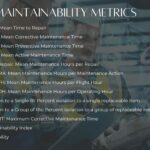
What Are the Benefits of Maintainability Prediction?
Performing a Maintainability Prediction analysis offers significant advantages at every stage of the product lifecycle. Its primary goal is to optimize maintenance and repair strategies using measurable, data-driven insights, which is difficult to achieve without quantified metrics.
Maintainability Prediction analysis can be performed during the product design stage, enabling you to estimate your maintainability metrics prior to deployment. Making changes at this stage is often easier and more cost-effective than later stages in the product lifecycle. You can use this information to optimize your design to ensure that maintenance and repair activities can be performed efficiently and that system downtime is minimized.
Maintainability Prediction analysis is also useful once a system is up and operational. By evaluating all of the system’s corrective and preventive maintenance actions, Maintainability Prediction analysis can provide insight into the activities or components most affecting system availability. Unacceptable downtimes could be caused by several issues, such as poor repair procedures, inability to isolate a fault correctly, or inefficiencies that cause the repair process to be too cumbersome or difficult to perform. Maintainability Predictions can help you uncover the root causes of excessive downtime and provide insight to enable you to improve availability.
Used in any or all stages of the product lifecycle, Maintainability Predictions offer several key benefits.
Increased System Availability
Predicting and improving maintainability helps to minimize the time required for repairs and service. For critical systems, especially those where uptime is mandated, Maintainability Prediction can help to ensure that availability performance goals are met. On manufacturing lines of these critical systems, this translates into increased output and fewer disruptions.
Improved Product Design
Through the performance of Maintainability Prediction during the product design stage, products can be evaluated for ease of repair and servicing. In this manner, problem areas can be addressed at the start by optimizing component layout, improving accessibility, and incorporating modular design. Supporting a design for maintainability mindset from the outset ultimately leads to systems that meet uptime objectives.
Better Maintenance Planning
Performing a Maintainability Prediction analysis allows you to identify high-maintenance areas and target them for improvement. This leads to more efficient maintenance schedules and procedures to ensure low system downtime. By reviewing repair and maintenance procedures, you will be able to understand the tools, parts, and skills required to complete repair tasks. This will help schedule efficient maintenance and manage resource allocations.
Lower Costs
By optimizing repair and maintenance activities, your overall cost for keeping your system operational will be lowered. Disruptions are minimized and handled more efficiently when they occur, leading to improved system availability and reduced lost productivity and revenue.
When products are designed with maintainability in mind, repairs are more efficient. For example, by requiring fewer specialized tools or simplifying failure isolation for a repair, downtime is minimized, and labor cost is reduced.
Achieved Compliance
Many industries must meet maintainability analysis requirements for compliance. Some may need to certify in accordance with MIL-HDBK-472, MIL-STD-470, NASA-TM-428, or ISO 26262. By adding Maintainability Prediction to your analysis toolset, you can help meet your compliance goals.

What Industries Perform Maintainability Prediction Analyses?
Many industries use Maintainability Prediction analysis to evaluate system maintainability. By providing a structured, data-driven approach to analyzing maintenance activities, it helps organizations gain insight into repair processes and proactively drive improvements in maintenance efficiency and cost control.
Aerospace and Defense
Aerospace and defense systems have long operational lifespans and strict safety standards. Downtime in this sector can be extremely costly, and system uptime is often mission critical. The critical nature of failures and repairs in the aerospace and defense sector makes Maintainability Prediction a key element in ensuring system success.
For example, Maintainability Prediction can be used to evaluate how long it takes to repair components such as a radar system on a military aircraft. This helps to optimize repair policies to ensure high readiness.
Automotive
Repair and service of vehicles is of utmost importance in the automotive industry. For this reason, Maintainability Prediction analysis is key to meeting service-related goals. First, it is key to ensure vehicles are easily and efficiently serviced for repairs and maintenance. Secondly, keeping vehicle repair times to a minimum and ensuring customers get back on the road quickly is essential to achieving high levels of customer satisfaction. Additionally, optimizing maintenance procedures reduces warranty costs.
For example, an electronic vehicle manufacturer can use Maintainability Prediction to aid in optimizing battery replacement procedures, improving turnaround times and reducing labor complexity.
Manufacturing & Industrial Equipment
Manufacturing and assembly lines rely on high system uptime for success. Any downtime of a manufacturing line directly impacts production, leading to loss of revenue. Manufacturers use Maintainability Prediction not only to help with system repair, but also to help optimize preventive maintenance schedules and extend equipment life and prevent failures.
For example, a manufacturing plant can use Maintainability Prediction to evaluate MTTR for robotic arms or CNC machines to ensure efficient maintenance procedures and achieve high production output.
Railways & Transportation
For clear reasons, trains, subways, and transportation systems require high availability and safety to minimize disruption for passengers. Maintainability Prediction helps ensure that critical subsystems are easy to service and maintain.
For example, Maintainability Prediction can be used to assess the maintainability of brake systems for high-speed trains.
Medical Devices
Due to their direct impact on patients, medical devices have strict downtime and safety requirements. Oftentimes in this industry, compliance with regulatory standards is essential. Maintainability Prediction is critical to meeting regulatory and performance requirements in the medical device industry.
For example, Maintainability Prediction can be used to predict how long it will take a technician to service an MRI machine, ensuring minimal disruption to clinical operations.
Consumer Electronics
Consumer electronics manufacturers recognize the value of quality products to retain high levels of customer satisfaction. Reliability is important, but so is maintainability. A product that is easily repaired, even after failure, can still leave a positive impression.
For example, a manufacturer of laundry appliances can use Maintainability Prediction to evaluate the difficulty of servicing a dryer to reduce service time and enhance customer satisfaction.
Energy (Power Plants, Wind Farms, etc.)
Those in the energy sector must maintain critical infrastructure, sometimes in remote and/or hazardous environments. Maintainability Prediction analyses are used to ensure energy equipment is easily serviceable.
For example, Maintainability Prediction can predict MTTR for gearboxes or blades of offshore turbines in order to identify factors that make repairs difficult or lengthy.

How Do I Perform a Maintainability Prediction?
Maintainability Prediction follows a structured, repeatable process designed to ensure consistency, accuracy, and actionable results. The steps below outline the most common approach for conducting a reliable and efficient Maintainability Prediction analysis.
1. Determine Maintainability Objectives
The first step is to determine your own maintainability goals. These objectives are unique to your industry and may be compliance driven. Work with your engineering team to define the measures you will evaluate and the performance goals you want to achieve. Consider not just regulatory requirements, but your own internal goals and customer expectations. These can include:
- Which metrics you want to evaluate (e.g., MTTR, Availability)
- What performance targets you aim to achieve
- Any standards (e.g., MIL-HDBK-472) you will follow
2. Define the System
Next, create a detailed description of the system to analyze, including all components and system structure. Various tools can be used to define the system like software modeling tools.
Oftentimes, Maintainability Prediction analysis is done in conjunction with Reliability Prediction. This enables you to define your system as well as assess component failure rates. The predicted failure rates are then used in Maintainability Prediction to help with computing maintainability metrics.
3. Describe Repair and Maintenance Procedures
The next step is to go through your system and define the repair and/or maintenance procedures for each repairable item. This can include:
- The step-by-step process taken upon failure to repair the system to an operational state
- The tools and personnel required for each task
- The estimated time to complete each step
You may also include preventive maintenance tasks if you want to evaluate preventive metrics in addition to corrective metrics.
4. Perform Maintainability Prediction Calculations
Once the system and the repair procedures are defined, it is time to perform the Maintainability Prediction analysis. Using a software tool, such as Relyence Maintainability Prediction, you can select the metrics you want to compute and allow the software to perform the necessary calculations.
5. Review and Optimize
It is now time to review the output results from the Maintainability Prediction. If changes need to be made to attain your objectives, review areas of concern and target those where improvements are required. This may involve changing the procedure, optimizing the process, or potentially even making a design change. Some ideas to consider include:
- Improve component modularity for ease of replacing of faulty parts
- Design for ease of access to reduce disassembly steps
- Reduce the number or complexity of tools required
- Implement self-diagnostics to isolate faults
6. Continuously Monitor
It is important to continually collect real-world repair and maintenance data from technicians, service centers, production lines, etc. This enables you to compare predicted metrics with actual field data. You can then refine and update your ongoing Maintainability Prediction analysis based on real-world performance.

Example Maintainability Prediction Calculation
To demonstrate how Maintainability Prediction works in practice, we will focus on a quadcopter drone and utilize the Relyence Maintainability Prediction software. Note that we will obtain failure rate data for our calculations using Relyence Reliability Prediction.
Step 1: Define Maintainability Objectives
For this example, we’ll focus on two key repair metrics for the main circuit board of our drone: MTTR and Availability. We want to make sure our MTTR is less than 5 minutes, and our Availability is very high—at least 0.99996.
Step 2: Define the System
Our example drone includes two main subsystems: a Motherboard with a built-in GPS and a Ground Controller unit. Since we are going to use estimated failure rates of our system components to perform our Maintainability Prediction analysis, we will use Relyence Reliability Prediction to define our system breakdown. We will also enter all the parts of our subsystems to enable Relyence Reliability Prediction to compute our failure rates. Our system breakdown looks like this:
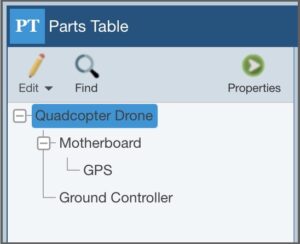
Once we have entered all the parts of our drone components and performed a Reliability Prediction calculation, we obtain these failure rate results:
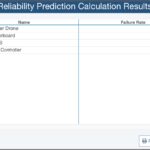
Step 3: Describe Repair and Maintenance Procedures
For this example, we are going to focus on the Motherboard. Using Relyence Maintainability Prediction, we enter the repair tasks required for the Motherboard. In the case of Motherboard failure, we are going to remove the failed unit and replace it with a new one:
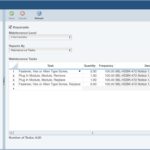
Step 4: Perform Maintainability Prediction Calculations
Next, we compute MTTR and Availability for the Motherboard:
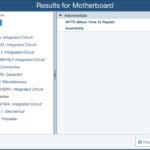
Step 5: Review and Optimize
MTTR is expressed in units of hours, so our MTTR of 0.023333 is equal to approximately 1.4 minutes. Our Availability is also very high at 0.999999. For this very simple case, we’ve met our objectives.
In this case, due to ideal design, the Motherboard is easily accessible and only requires removing screws to efficiently remove and replace. If the Motherboard was in a less accessible location and required more effort to reach, such as removing other parts, this repair would not be as efficient. In that case, a design change could be considered to improve future maintainability.
For more complex systems with many steps, reviewing overall procedures and addressing bottlenecks would be required to optimize repair times when our objectives are not achieved.
Step 6: Continuously Monitor and Review
Once our drone is in the field, we can track and review failure and repair reports. This allows us to make sure that the repair times match the MTTR estimate of 1.4 minutes to replace a failed Motherboard and that Availability remains high.
A corrective action tracking system, such as Relyence FRACAS (Failure Reporting, Analysis, and Corrective Action System), is often used for this type of data collection. A FRACAS tool enables you to record failures, technician reports, repair times, and related information. It also provides a closed-loop system to ensure that reported issues are corrected and to verify that corrective actions were successful.
Take a look at our comprehensive overview of Maintainability Prediction for more in-depth details about the elements involved in performing Maintainability Prediction analysis including an example.
Relyence Maintainability Prediction
Relyence Maintainability Prediction is a browser-based, comprehensive package for performing Maintainability Prediction analysis. It fully implements MIL-HDBK-472 and offers a host of features to make your maintainability prediction tasks quick and efficient. Relyence Maintainability Prediction also provides a solid foundation for all your maintenance and repair analysis needs and adds a key element to your reliability and quality analysis tool set.
Contact us today to discuss your Maintainability Prediction needs, sign up today for our free trial to see Relyence Maintainability Prediction in action, or schedule a personalized demo with one of our knowledgeable team members.





